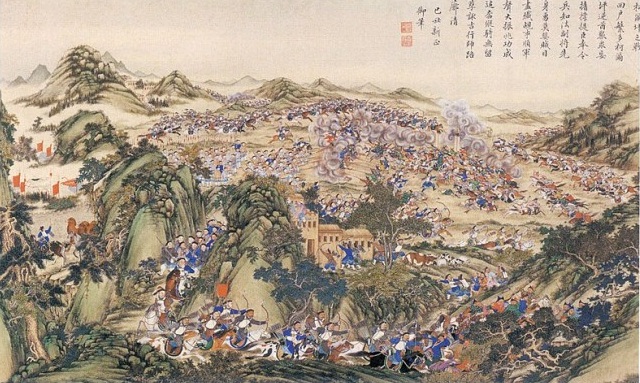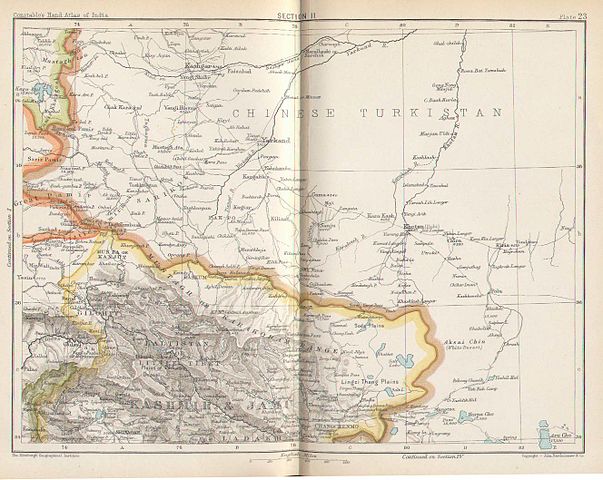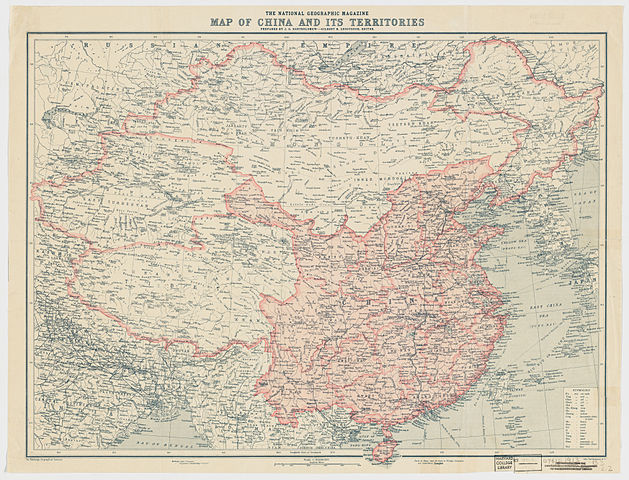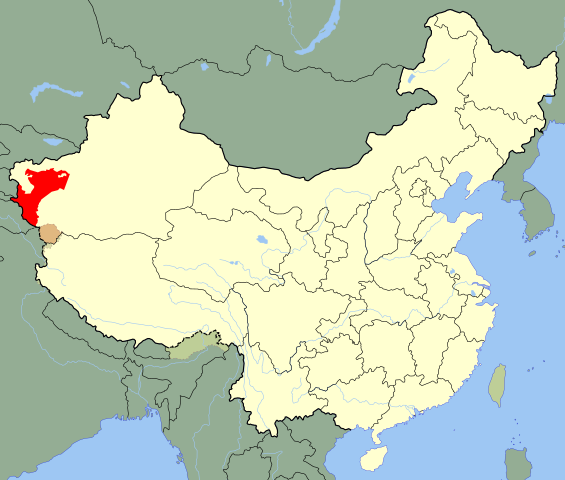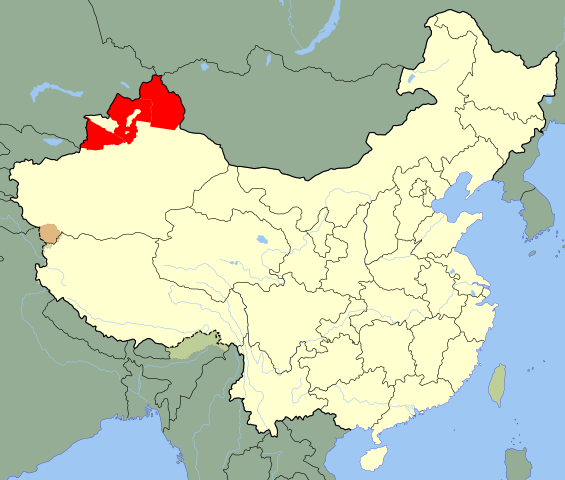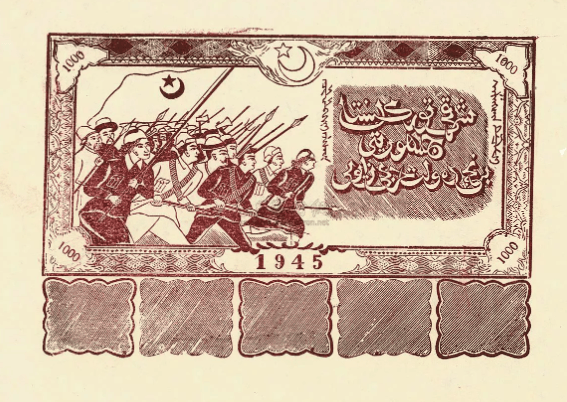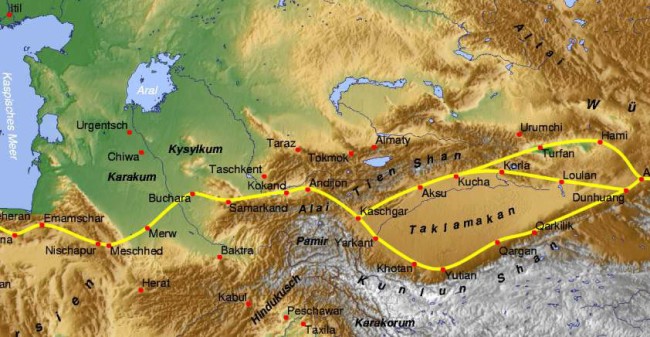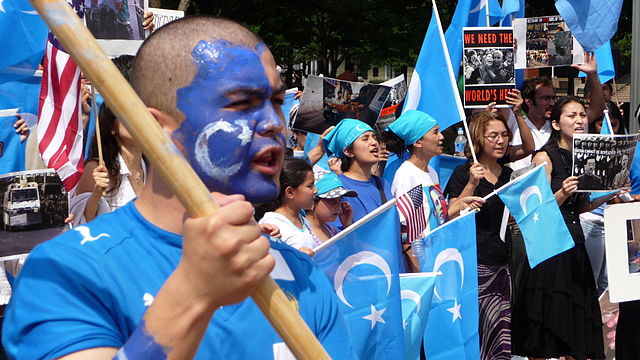
| EAST TURKESTAN
Xinjiang, which is the broadest extent of the usage of "East Turkestan" Languages : Uyghur, Chinese, Kazakh, Kyrgyz, Oirat and Mongolian
Ethnic groups : 45.84% Uyghur, 40.48% Han Chinese, 6.50% Kazakh, 4.51% Hui and 2.67% Other
East Turkestan, also East Turkistan, (ULY: Sherqiy Türkistan, Turkish: Dogu Türkistan) varies in meaning by context and usage. The term was coined in the 19th century by Russian Turkologists including Nikita Bichurin to replace another Western term, Chinese Turkestan, which referred to the Tarim Basin in the southwestern part of Xinjiang during the Qing Dynasty. The medieval Persian toponym "Turkestan" and its derivatives were not, however, used by the local population. The Uyghur name for the Tarim Basin is Altishahr, which means "Six Cities" in Uyghur. Besides, China had since the Han Dynasty had its own name for an overlapping area: the "Western Regions." The parts of this area controlled by China were termed "Xinjiang" starting in the 18th century.
From the 20th century on, Uyghur separatists and their supporters used East Turkestan (or Uyghurstan) as an appellation for the whole of Xinjiang or for a future independent state in present-day Xinjiang Uyghur Autonomous Region (presumably with Ürümqi as its capital). They reject the name of Xinjiang (meaning "New Frontier" in Chinese) because of the Chinese perspective reflected in the name and prefer East Turkestan to emphasize connection to other, westerly, Turkic groups. However, even in nationalist writing, East Turkestan retained its older, more narrow geographical meaning.
The First East Turkestan Republic existed from November 12, 1933 until April 16, 1934 and the second Second East Turkestan Republic existed between November 12, 1944 and December 22, 1949. East Turkestan is a founding member of the Unrepresented Nations and Peoples Organization (UNPO), which was formed in 1991, where it is represented by the World Uyghur Congress. In September 2004, the East Turkistan Government-in-Exile was established in Washington, DC.
History
:
Cities of the Tarim Basin region, 1 BC In China, the term Western Regions (Chinese: pinyin: Xiyù; Wade–Giles: Hsi1-yü4; Uyghur: Qurighar) [citation needed] referred to the regions west of the Yumen Pass and more specifically the Tarim Basin in Xinjiang that had come under the Han dynasty's control since 60 BC. Since the Han, successive Chinese governments had to deal with secessionist movements and local rebellions from different peoples in the region. However, even when Xinjiang was not under Chinese political control, Xinjiang has long had "close contacts with China" that distinguish it from the independent Turkic countries of Central Asia. The Gökturks, known in ancient Chinese with pronunciation as Tutkyud as well as modern Chinese pronunciation as Tujue (Tu-chueh; Chinese: pinyin: Tujué; Wade–Giles: T'u1-chüeh2) united the Turkic peoples and created a large empire, which broke into various Khanates; the West Tujue Khanate inherited Xinjiang, but West Tujue became part of China's Tang dynasty until the 9th century. However, the terms for West Tujue and East Tujue do not have any relation with the terms West and East Turkestan."Turkestan", which means "region of the Turks", was defined by Arab geographers in the ninth and tenth centuries as the areas northeast of the Sir River. For those Arab writers, the Turks were Turkic-speaking nomads and not the sedentary Persian-speaking oasis dwellers. With the various migrations and political upheavals following the collapse of the Gökturk confederation and the Mongol invasions "Turkestan", according to the official Chinese position, gradually ceased to be a useful geographic descriptor and was not used.
Qing-era painting depicting a Chinese campaign against Jahangir Khoja's forces in Xinjiang, 1828 During the sixteenth century, the Chagatai Khanate completed the Islamification and Turkification of western Xinjiang and the surrounding region, known then as Moghulistan, while China's Ming dynasty held the Eastern Areas. After the Fall of the Ming dynasty, a western Mongol group established a polity in "Chinese Tartary" as it was sometimes known or in eastern Xinjiang, expanding southward into southern Xinjiang. In 1755, the Qing dynasty defeated the Mongol Dzungar Khanate and captured two territories in Xinjiang. The northern territory, where the Dzungars lived, was called Dzungaria, while the southern areas which the Dzungars controlled and mined were called Huijiang (Hui-chiang; Chinese: pinyin: Huíjiang; Wade–Giles: Hui2-chiang1; lit.: 'Muslim territory') or Altishahr. The term "Xinjiang", which up until that time simply meant all territories new to the Qing, gradually shifted in meaning for the Qing court to exclusively mean Dzungaria and Altishahr taken together. In 1764, the Qianlong Emperor made this use of Xinjiang as a proper name official and issued an imperial order defining Xinjiang as a "provincial administrative area". After General Tso suppressed the Dungan revolt in 1882, Xinjiang was officially reorganized into a province and the name Xinjiang was popularized, superseding "Xiyu" in writing.
At the same time as the Chinese consolidation of control in Xinjiang, explorers from the British and Russian empires explored, mapped, and delineated Central Asia in a competition of colonial expansion. Several influential Russians would propose new terms for the territories, as in 1805 when the Russian explorer Timovski revived the use of "Turkestan" to refer to Middle Asia and "East Turkestan" to refer to the Tarim Basin east of Middle Asia in southern Xinjiang or in 1829, when the Russian sinologist Nikita Bichurin proposed the use of "East Turkestan" to replace "Chinese Turkestan" for the Chinese territory east of Bukhara. The Russian Empire mused expansion into Xinjiang, which it informally called "Little Bukhara". Between 1851 and 1881, Russia occupied the Ili valley in Xinjiang, and continued to negotiate with the Qing for trading and settlement rights for Russians. Regardless of the new Russian appellations, the original inhabitants of Central Asia generally continued not to use the word "Turkestan" to refer to their own territories.
Map including part of Chinese Turkistan (1893) After a spate of annexations in Middle Asia, Russia consolidated its holdings west of the Pamir Mountains as the Turkestan Governorate or "Russian Turkestan" in 1867. It is at this time that Western writers began to divide Turkestan into a Russian and a Chinese part. Although foreigners acknowledged that Xinjiang was a Chinese polity, and that there were Chinese names for the region, some travelers preferred to use "names that emphasized Turkic, Islamic, or Central Asian, i.e., non-Chinese characteristics". For contemporary British travelers and English-language material, there was no consensus on a designation for Xinjiang, with "Chinese Turkestan", "East Turkestan", "Chinese Central Asia", "Serindia" and "Sinkiang" being used interchangeably to describe the region of Xinjiang. Until the 20th century, locals used the names of cities or oases in their "territorial self-perception", that expanded or contracted as needed, such as Kashgaria out of Kashgar to refer to southwestern Xinjiang. Altishahr, or "six cities", collectively referred to six vaguely defined cities south of the Tian Shan.
Early 20th century :
Map including East Turkestan (NGS, 1912)
In 1912, the Xinhai Revolution overthrew the Qing Dynasty and created a Republic of China. As Yuan Dahua, the last Qing governor, fled from Xinjiang, one of his subordinates, Yang Zengxin, took control of the province and acceded in name to the Republic of China in March of the same year. In 1921, the Soviet Union officially defined the Uyghurs as the sedentary Turkic peoples from Chinese Turkestan as part of their nation building policy in Central Asia. Multiple insurgencies arose against Yang's successor Jin Shuren in the early 1930s throughout Xinjiang, usually led by Hui people. "East Turkestan" became a rallying cry for people who spoke Turki and believed in Islam to rebel against Chinese authorities. In the Kashgar region on November 12, 1933, Uyghur separatists declared the short-lived and self-proclaimed East Turkestan Republic (ETR), using the term "East Turkestan" to emphasize the state's break from China and new anti-China orientation.
$ 1000 East Turkistan Dollar Note, 1945 The First ETR gave political meaning to the erstwhile geographical term of East Turkestan. However, the Chinese warlord Sheng Shicai quickly defeated the ETR and ruled Xinjiang for the decade after 1934 with close support from the Soviet Union. Eventually, though, the Soviet Union exploited the change in power from Sheng to Kuomintang officials to create the puppet Second East Turkestan Republic (1944–1949) in present-day Ili Kazakh Autonomous Prefecture to exploit its minerals, later justifying it as a national liberation movement against the "reactionary" Kuomintang regime. Amid the anti-Han programs and policies and exclusion of "pagans", or non-Muslims, from the separatist government, Kuomintang leaders based in Dihua (Ürümqi) appealed to the long Chinese history in the region to justify its sovereignty over Xinjiang. In response, Soviet historians produced revisionist histories to help the ETR justify its own claims to sovereignty, with statements such as that the Uyghurs were the "most ancient Turkic people" that had contributed to world civilization. Traditionally, scholars had thought of Xinjiang as a "cultural backwater" compared to the other Central Asian states during the Islamic Golden Age. Local British and American consuls, also intrigued by the separatist government, published their own histories of the region. The Soviet Uyghur histories produced during its support of the ETR remain the basis of Uyghur nationalist publications today.
Late 20th century :
According to one definition of East Turkestan, the Tian Shan mountain
system separates East Turkestan from Dzungaria in Xinjiang.
21st
century :
On February 28, 2017, it was announced by the Qira County government in Hotan Prefecture that those who reported others for stitching the 'star and crescent moon' insignia on their clothing or personal items or having the words 'East Turkestan' on their mobile phone case, purse or other jewelry, would be eligible for cash payments.
Current
status :
Uyghur anti-China demonstration in Washington, D.C.
The term "East Turkestan" is primarily used by, and is
associated with, Uyghur separatists (diasporic protest in Washington,
D.C. shown)
Source :
https://en.wikipedia.org/ |
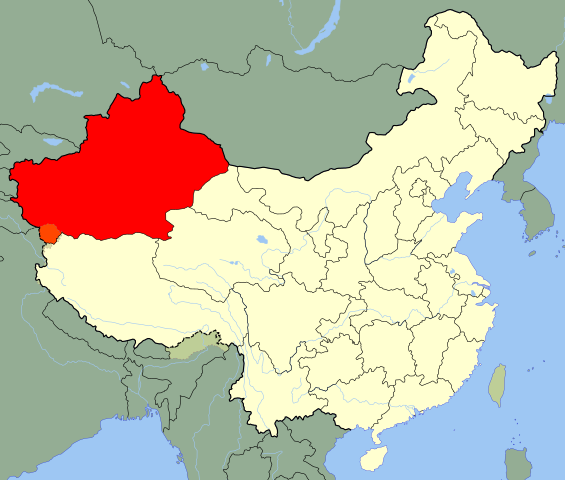
.jpg)
